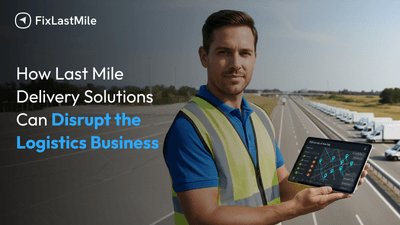You might have heard of the popular phrase “The last mile is often the longest mile to walk.” In logistics, it is not just a saying; it’s a wake-up call. Let’s understand it. According to the Statista Report 2024, the last mile delivery ranges around 53% of total shipping costs. Well, when it comes to last mile delivery, it either wins the customers loyalty or loses it entirely. If you are also facing the same situation, then this blog is for you. If you are managing or scaling a logistics startup, your last mile delivery operations play a very important role. Executing and operating them in a smarter way can enhance a better customer experience.
Let's unpack what last mile delivery is, how you can solve its toughest challenge, and why choosing the right and perfect solution can help your business startup scale faster and in a smarter way.
Meaning of Last Mile Delivery
Last mile delivery is the final step in the order fulfilment process, where goods are taken from the distribution centre and delivered to the customer’s doorstep. Additionally, it is the most expensive, complex and crucial part in the delivery process.
For startups, having inappropriate or poor last mile execution often leads to the following circumstances:
- Missed or Late deliveries
- Negative Customer Reviews
- High Operational Costs
- Customer Dissatisfaction
- Lack of Scalability
Nowadays, customers expect same-day or next-day delivery, live delivery tracking, on-time delivery, and no extra charges while delivering. So, startups should address these problems and enhance their last mile logistic solution.
Challenges Faced by Logistics Startups
Let’s look at the challenges that logistics startups are facing during the execution of their last mile delivery.
- Rising Fuel Costs: We all know that the prices of fuels are rising, and it is impacting the overall delivery operations. Startups often lack economies of scale, and when routes aren’t optimised, deliveries take time due to taking longer routes and inefficient driver allocation.
- Poor Tracking & Visibility: Now customers demand real-time updates, ETAs and delivery confirmations. But new startups lack these features in their deliveries, which results in the lack of the race. They usually use the manual tracking system, which results in blind spots that leave customers frustrated and teams with unsolved answers.
- Unoptimised Route Planning: Without intelligent route planning tools, delivery staff may follow static routes, encounter traffic delays, or handle orders inefficiently. This leads to longer delivery windows, low productivity, and excess fuel consumption.
- Operational Inefficiencies: Many startups manage deliveries through spreadsheets and outdated reporting tools. This leads to manual dispatch errors, delayed task assignments, and driver overload during the order surges.
- Low First-Attempt Delivery Rates: Missed deliveries not only result in extra delivery attempts, but they also hamper the customer experience and increase cost per delivery. Some of the most common reasons may include poor communication, unoptimised route planning, or inappropriate delivery slots.
- Scalability Issues: Imagine this: if someone is having 50 orders per day, and after a certain time, the number of orders increases to 100-120 per day. In that case, will your system be able to handle such a workload? This is where last mile delivery platform can be a game changer. Without automation and centralised visibility, logistics services can truly become overwhelmed, leading to service inconsistency.
- Lack of Driver Accountability: Early startups often find it difficult to monitor the driver performance, delivery times and productivity. Without any data insights, it's hard to reward efficiency and identify the training needs.
Traditional VS Modern Last Mile Delivery: A Deeper Comparison
For a better understanding, let’s look at the comparison of the traditional and modern delivery solutions:
| Aspect | Traditional last-mile Delivery | Modern Last Mile Delivery |
|---|---|---|
| Route Management | Fixed routes, Often assigned manually | Smart route planning that shifts with road conditions, order load, and live input |
| Tracking & Visibility | No live updates; basic manual logging | Live GPS tracking accessible to both businesses and their customers |
| Delivery Flexibility | One-size-fits-all schedule | On-demand, same-day, or scheduled delivery slots |
| Communication | Phone calls or delayed updates | Automated SMS/email alerts, live ETA notifications |
| Proof of Delivery | Paper-based, easily lost | Digital PODs with signature, image, and timestamp |
| Dispatching | Manual Assignments by Managers | Automated dispatch powered by driver location, vehicle capacity, and real-time availability |
| Data & Analytics | Limited to basic reporting | Central dashboards, performance analytics, route heatmaps |
| Scalability | Requires large team to manage more deliveries | Cloud-based platforms scale effortlessly with growth |
| Integration with Systems | Minimal or slow integrations | API-ready, fast integration with e-commerce platforms |
| Cost Optimization | High Costs due to Inefficiencies | Streamline routes to cut fuel costs, reduce labor hours, and avoid unnecessary detours. |
For early logistics startups, modern solutions are not just upgrades; they are the survival tools in the competitive world.
Benefits of Implementing Last Mile Delivery Solutions
- Increased Delivery Efficiency: AI route optimisation helps to drive fewer miles, deliver faster and get more done, all these things with smarter routes.
- Reduced Fuel & Labour Costs: Efficient routing and batch deliveries help to cut down the labour as well as the fuel costs. It reduces idle time and fuel consumption, even during high-volume periods.
- Improved Customer Experience: To build customer trust, transparency is needed. Live order tracking, timely notifications to customers, and on-time deliveries can enhance customer satisfaction and repeat business.
- Real-time Visibility for Teams: Operating teams gain end-to-end visibility into the entire delivery chain, which helps them in faster decisions, instant routing, and proactive customer updates.
- Enhanced Delivery Success Rates: Businesses can reduce the number of unsuccessful deliveries by implementing features like dynamic rescheduling, address validation and driver communication tools.
- Data-driven Decision-making: Having the key insights regarding delivery experiences and driver efficiency can make a huge difference.
- Scalability Without Added Overhead: Your system should not break as your order volume increases. Automated workflows and modular tools allow you to scale without increasing headcount.
- Competitive Advantage: In markets where speeds and reliability make the difference, a strong last-mile delivery setup becomes your friend in the growth engine.
See what benefits you can get by implementing the last mile delivery solutions.
What to Look for in a Last-Mile Delivery System
If you are analysing the solutions, always check these features which can help you fight the challenges:
- Smart Route Planning: React to traffic changes, hold-ups, and driver shifts in real time.
- Live Driver Tracking: This feature is helpful for both the operational team and the customers.
- Auto Dispatching: Manual dispatching is slow and tedious—automation makes it quick and efficient. Using the appropriate and right algorithms to assign the right driver for the right job can make a huge impact on your business.
- Centralised Analytics: This feature helps you to view your order performance, drivers KPIs and customer satisfaction all in one place.
- Mobile App for Drivers: This feature helps the drivers to take the proof of delivery through e-signatures, real-time status updates, and delivery notes and helps the drivers in taking routes turn by turn.
- Customer Notifications: This feature helps to send SMS/email notifications timely to customers and keep them informed about the order progress and delivery windows.
However, these features will help you to solve most of the problems you are facing, and it also helps to choose the best last mile delivery solutions.
Why FixLastMile is Ideal for Logistics Startups
Unlike enterprise logistics systems designed for corporations, FixLastMile is built from the ground up for startups. Quick to launch, easy to use, and scalable for any size operation.
Here’s what makes FixLastMile a smart choice:
- Fast Setup: Get started in days, not months.
- Plug-and-Play Integrations: Connect to your order management systems or third-party apps.
- Driver Mobile App: Track tasks, collect proof of delivery, and navigate routes, all from one app.
- Customer-Centric Experience: Offer real-time delivery updates, feedback loops, and rescheduling options.
- Modular & Scalable: Only pay for what you use; scale features as you grow.
Not only these features, but FLM is having a lot of such features which can help your business grow.
Wrapping Up
In the delivery game, your final step is your biggest differentiator. If you’re launching or managing a logistics startup, your success depends on getting the last mile right, not just for today’s customers but tomorrow’s scale. FixLastMile helps you solve the chaos of deliveries with one intelligent platform, designed specifically for fast-moving, resource-tight, growth-hungry startups.
Ready to Deliver Smart?
Start strong with FixLastMile. Get started with a free demo and take control of your logistics with last mile delivery software today.
FAQs
For small fleets and resource-strapped startups, the real challenge lies in delivering efficiency without compromising customer satisfaction. Lack of route optimisation and tracking tools often leads to missed deliveries and rising costs.
You can use an automated last mile delivery platform like FixLastMile to handle dispatch, tracking, notifications, and performance monitoring. This helps your small team operate like a much larger one.
Absolutely. FixLastMile supports both scheduled and on-demand deliveries, including food, groceries, medicine, and courier services with real-time tracking and ETAs.
FixLastMile is purpose-built for startups. It's scalable, fast to deploy, and focused on making delivery logistics simpler, not more complicated. Its AI-powered route planning and customer-first design make it a standout choice for growing teams.




